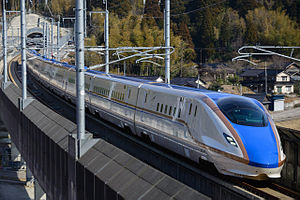Kagayaki
 A JR West W7 series train on the Hokuriku Shinkansen | |
| Overview | |
|---|---|
| Service type | Shinkansen |
| Status | Operational |
| Locale | Japan |
| First service | 13 March 1988 (Limited express) 14 March 2015 (Shinkansen) |
| Current operator(s) | JR East/JR West |
| Route | |
| Termini | Tokyo Kanazawa |
| Stops | 3 |
| Average journey time | 2 hrs 28 mins |
| Service frequency | 10 return services daily |
| Line(s) used | Hokuriku Shinkansen |
| On-board services | |
| Class(es) | Gran Class + Green + Ordinary |
| Technical | |
| Rolling stock | E7 series, W7 series |
| Track gauge | 1,435 mm (4 ft 8+1⁄2 in) |
| Electrification | 25 kV AC, 50/60 Hz overhead |
| Operating speed | 260 km/h (160 mph)* |
The Kagayaki (かがやき, lit. "glitter" or "luster") is a high-speed shinkansen train service jointly operated by East Japan Railway Company (JR East) and West Japan Railway Company (JR West) between Tokyo and Kanazawa on the Hokuriku Shinkansen line in Japan. The shinkansen service was introduced on 14 March 2015, but the name was first used for a limited express service operated by JR West from March 1988 until March 1997.
Service outline
The Kagayaki services are the fastest services operating on the Hokuriku Shinkansen, with most services stopping at only Saitama, Nagano, and Toyama en route (some services also stop at Ueno).[1] Travelling at a maximum speed of 260 km/h (160 mph)*, the fastest services take 2 hours 28 minutes for the journey between Tokyo and Kanazawa.[1]
Rolling stock
- E7 series 12-car sets based at Nagano Depot, since 14 March 2015
- W7 series 12-car sets based at Hakusan Depot, since 14 March 2015
Kagayaki services are operated using JR East E7 series and JR West W7 series 12-car train sets based at Nagano and Hakusan depots respectively.[1]
-
A JR East E7 series train
Pre-shinkansen
- 485 series 4/6-car EMU sets (March 1988 - March 1997)
Formations
Kagayaki shinkansen services use 12-car JR East E7 series and JR West W7 series trainsets, formed as follows, with car 1 at the Tokyo (southern) end. Cars 1 to 10 are ordinary-class cars with 2+3 seating, car 11 is a "Green" car with 2+2 seating, and car 12 is a "Gran Class" car with 2+1 seating. All cars are reserved and no-smoking.[2]
| Car No. | 1 | 2 | 3 | 4 | 5 | 6 | 7 | 8 | 9 | 10 | 11 | 12 |
|---|---|---|---|---|---|---|---|---|---|---|---|---|
| Accommodation | Reserved | Reserved | Reserved | Reserved | Reserved | Reserved | Reserved | Reserved | Reserved | Reserved | Green | Gran Class |
| Facilities | Toilets | Toilets, phone | Toilets | Wheelchair space, accessible toilet, phone | Toilets | Wheelchair space, accessible toilet | Toilets |
History

The Kagayaki service was introduced on 13 March 1988 as a limited express service operating between Kanazawa and Nagaoka, to provide a connection travelling to and from Tokyo via the Joetsu Shinkansen.[3] Services operated at a maximum speed of 120 km/h (75 mph)*,[3] and stopped at Toyama, Toyama, and Naoetsu only.[4]
March 1988 – March 1990
From their introduction in March 1988, services were normally formed of 4-car 485 series dual-voltage (AC/DC) electric multiple units (EMUs) based at Kanazawa Depot, as shown below, with car 1 at the Kanazawa end.[5]
| Car No. | 1 | 2 | 3 | 4 |
|---|---|---|---|---|
| Numbering | KuHa 481 | MoHa 484 | MoHa 485 | KuHa 481 |
| Accommodation |
March 1990 – March 1991
From March 1990, services were normally formed of 6-car Kanazawa-based 485 series EMUs, as shown below, with car 1 at the Kanazawa end.[5] From January 1991, a "Green" (first class) car was added to the formations.[3]
March 1991 – March 1992
From March 1991, services were normally formed of 6-car Kanazawa-based 485 series EMUs with a Green (first class) car, as shown below, with car 1 at the Kanazawa end.[5]
March 1992 – March 1997
From March 1992, services were normally formed of 6-car Kanazawa-based 485 series EMUs, as shown below, with car 1 at the Kanazawa end and car 6 designated as a non-reserved seating car.[4][5] Car 1 was divided into smoking and no-smoking sections.[5] At busy periods, trains often ran as 8-car formations.[3]
Kagayaki limited express services were discontinued from 23 March 1997, with the opening of the Hokuhoku Line and the introduction of new Hakutaka services connecting with the Joetsu Shinkansen at Echigo-Yuzawa.[3]
Shinkansen Kagayaki (March 2015 – )
From 14 March 2015, the name Kagayaki was reinstated for use on limited-stop services operating between Tokyo and Kanazawa following the opening of the Hokuriku Shinkansen beyond Nagano.[6]
See also
References
- ^ a b c 長野~金沢のあらまし. Tetsudō Daiya Jōhō Magazine (in Japanese). Vol. 44, no. 371. Japan: Kōtsū Shimbun. March 2015. pp. 12–14.
{{cite magazine}}: Unknown parameter|trans_title=ignored (|trans-title=suggested) (help) - ^ JR Timetable. Japan: Kotsu Shimbunsha. February 2015. EAN 4910053110259.
- ^ a b c d e Teramoto, Mitsuteru (July 2001). 国鉄・JR列車名大辞典. Tokyo, Japan: Chuoshoin Publishing Co., Ltd. pp. 164–165. ISBN 4-88732-093-0.
{{cite book}}: Unknown parameter|trans_title=ignored (|trans-title=suggested) (help) - ^ a b 列車名鑑1995. Japan: Railway Journal. August 1995. p. 62.
{{cite book}}: Unknown parameter|trans_title=ignored (|trans-title=suggested) (help) - ^ a b c d e JR特急電車編成表 1987~2012. Japan: Kotsu Shimbunsha. February 2012. pp. 126–139. ISBN 978-4-330-27012-8.
{{cite book}}: Unknown parameter|trans_title=ignored (|trans-title=suggested) (help) - ^ 北陸新幹線の列車名の決定について (pdf). News release (in Japanese). Japan: JR East & JR West. 10 October 2013. Retrieved 10 October 2013.
{{cite web}}: Unknown parameter|trans_title=ignored (|trans-title=suggested) (help)





